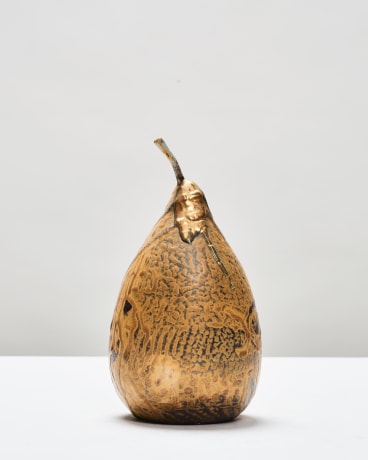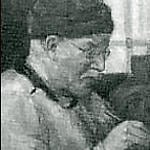

Nothing is known of the childhood or education of French sculptor and ceramist Emile Grittel (1870-1953). Before he became an artist, he served three years as a firefighter in Clichy. With his civic duty behind him, he went to work as a sculptor and bronzier in the workshops of a Parisian decorator Georges Hoentschel (1855-1915). Hoentschel had worked closely with ceramist and sculptor Jean Carriès (1855-1894), enlisting Carriès and the artisans in his employ to create Japonist vessels. After Carriès' death in 1894, Hoentschel purchased his estate and acquired his factory and studio. He hired Émile Grittel (1870-1953), who had been working for him as a sculptor and bronze founder, to supervise Carriès's artisans in the continued production of stoneware. Grittel operated his own pottery studio in Clichy while working for Hoentschel.
Grittel began working in Carriès's former workshop in 1895. Soon after he started, Hoentschel's preferences shifted from the sedate Japanese style to the flashier, naturalistic Art Nouveau style. His clients apparently had begun to demand items with sculptural ornamentation and touches of gold. Grittel complied but not without a struggle: he wanted creative independence but needed to work. The two men continued to cooperate but in 1902 a bitter argument caused them to part ways. When Hoentschel stopped using the Puisaye atelier, Grittel relocated to Clichy-sur-Garenne and went into business by himself. After his feelings of betrayal had calmed, Hoentschel became Grittel's principal client for the ceramics, bronzes, furniture, boiseries, and ornaments favored by his clients. The older man often visited Grittel to supervise production. Grittel continued to anonymously manufacture ceramics for Hoentschel until 1910. In his final years, Hoentschel worked in Grittel's Paris studio.
Grittel first showed ceramics and sculpture under his own name in 1914, one year before Hoentschel's death. His work became more personal and remained true to the Japanese influences that had permeated Carriès' work. Between 1920 and 1939, Grittel participated in major exhibitions on a regular basis. It is likely that World War II put an end to the demand for the luxury items he produced. He died in 1953 and is buried in Clichy.